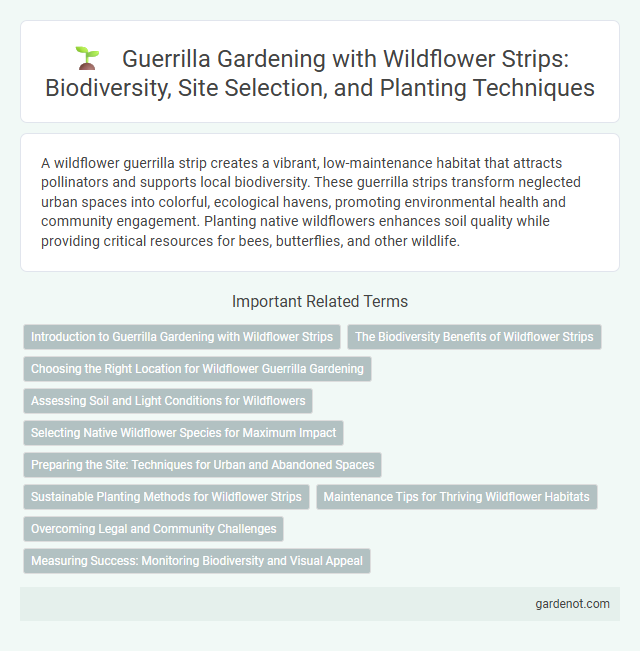A wildflower guerrilla strip creates a vibrant, low-maintenance habitat that attracts pollinators and supports local biodiversity. These guerrilla strips transform neglected urban spaces into colorful, ecological havens, promoting environmental health and community engagement. Planting native wildflowers enhances soil quality while providing critical resources for bees, butterflies, and other wildlife.
Introduction to Guerrilla Gardening with Wildflower Strips
Guerrilla gardening involves planting wildflower strips in neglected urban areas to enhance biodiversity and beautify cityscapes. These wildflower strips support pollinators like bees and butterflies, contributing to healthier ecosystems and improved air quality. By transforming unused spaces, guerrilla gardening fosters community engagement and raises environmental awareness.
The Biodiversity Benefits of Wildflower Strips
Wildflower strips in guerrilla gardening significantly boost local biodiversity by providing essential habitats and nectar sources for pollinators like bees, butterflies, and hoverflies. These strips support a diverse range of flora and fauna, enhancing ecosystem stability and promoting natural pest control by attracting beneficial insects. Establishing wildflower strips contributes to improved soil health and increased ecological resilience in urban and rural environments.
Choosing the Right Location for Wildflower Guerrilla Gardening
Selecting the ideal site for wildflower guerrilla gardening involves identifying unused or neglected urban spaces with ample sunlight and minimal foot traffic. Areas like vacant lots, roadside verges, and abandoned industrial plots offer fertile ground for thriving wildflower strips that support biodiversity and pollinators. Soil quality and moisture levels should be assessed to ensure optimal wildflower growth, enhancing urban ecological restoration efforts.
Assessing Soil and Light Conditions for Wildflowers
Guerilla wildflower strips thrive when soil pH ranges between 6.0 and 7.5, supporting diverse native species. Assess soil texture and drainage to ensure the medium is neither too compacted nor waterlogged, optimizing root health. Light conditions should be evaluated for at least six hours of direct sunlight daily, as most wildflowers require full to partial sun for vigorous growth.
Selecting Native Wildflower Species for Maximum Impact
Selecting native wildflower species for a guerrilla strip enhances local biodiversity and supports pollinator populations effectively. Prioritize species adapted to the regional climate and soil conditions, such as Echinacea purpurea, Asclepias tuberosa, and Solidago canadensis, to ensure resilience and seasonal bloom variety. Incorporating a mix of perennial and annual natives maximizes ecological benefits and visual impact throughout the growing season.
Preparing the Site: Techniques for Urban and Abandoned Spaces
Preparing the site for a guerilla wildflower strip in urban and abandoned spaces involves thorough soil testing and remediation to ensure adequate nutrients and pH balance for native wildflowers. Removing debris, invasive species, and compacted layers is essential to create a hospitable environment for seed germination and root growth. Incorporating organic matter and using minimal tilling techniques supports soil health while maintaining the natural ecosystem dynamics crucial for sustainable urban wildflower establishment.
Sustainable Planting Methods for Wildflower Strips
Guerilla strips use sustainable planting methods that emphasize native wildflower species to enhance local biodiversity and improve soil health. These planting techniques typically avoid synthetic fertilizers and pesticides, relying on natural processes to promote plant growth and resilience. Establishing wildflower strips through minimal soil disturbance helps maintain existing ecosystems while providing essential habitats for pollinators and other wildlife.
Maintenance Tips for Thriving Wildflower Habitats
Guerilla wildflower strips require minimal but strategic maintenance to sustain vibrant ecosystems and support pollinators. Regularly monitoring for invasive species and selectively removing weeds prevents competition, allowing native wildflowers to thrive. Periodic light mowing after seed dispersal encourages healthy regrowth and enhances habitat diversity for insects and wildlife.
Overcoming Legal and Community Challenges
Guerilla wildflower strips often face legal restrictions due to municipal codes regulating public land use, requiring careful navigation of permits and local ordinances. Engaging with community stakeholders and presenting ecological benefits such as pollinator support and stormwater management helps build local support and mitigate opposition. Strategic collaboration with environmental groups and clear communication of conservation goals further overcome regulatory and social barriers.
Measuring Success: Monitoring Biodiversity and Visual Appeal
Measuring the success of a Guerilla strip involves monitoring biodiversity metrics such as species richness, pollinator visitation rates, and native plant establishment, which indicate ecological health and habitat value. Visual appeal is assessed through plant coverage density, flowering duration, and aesthetic diversity that attract community engagement and support. Regular data collection using standardized protocols ensures adaptive management to enhance both ecological function and public appreciation.
Guerilla strip Infographic

 gardenot.com
gardenot.com